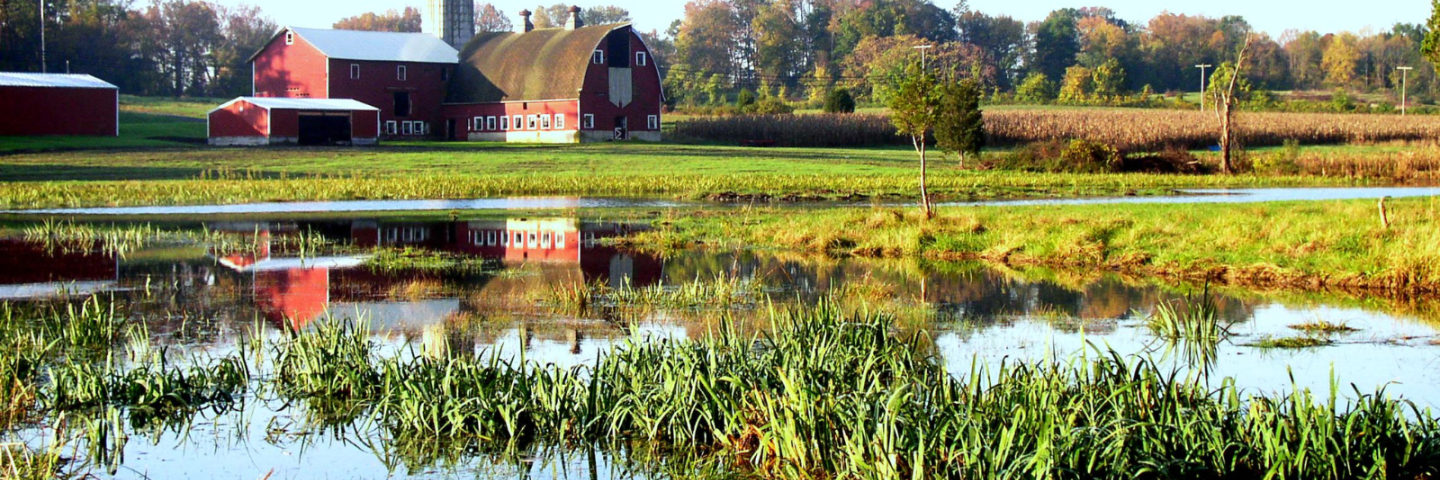Save New Jersey's Wetlands and Ensure the Future of Agriculture with ACEP
The Natural Resource Conservation Service is now accepting applications for the Agricultural Conservation Easement Program

Wetlands Reserve Easements (WRE) help private and tribal landowners protect, restore and enhance wetlands which have been previously degraded due to agricultural uses.
Program at a Glance
Through WREP, state agencies, county and local governments, non-governmental organizations and American Indian tribes are encouraged to submit proposals for priority project areas to collaborate with NRCS through program and partnership agreements. Once a proposal is accepted for funding the partners work with tribal and private landowners who voluntarily enroll eligible land into easements to protect, restore and enhance wetlands on their properties.
The voluntary nature of NRCS easement programs enables effective integration of wetland restoration on working landscapes, providing benefits to farmers and ranchers who enroll in the program, as well as benefits to the communities where the wetlands exist. Easements enable landowners to adopt a variety of conservation practices with the help of funding from NRCS that improve the function and condition of wetlands. .
Benefits
Wetland Reserve Easements protect important wetlands within an agricultural landscape, provide habitat for fish and wildlife, including threatened and endangered species, improve water quality by filtering sediments and chemicals, reduce flooding, recharge groundwater, protect biological diversity and provide opportunities for educational, scientific and limited recreational activities.
Partner benefits through WREP agreements include:
How Does It Work?
Through WREP, under the Wetlands Reserve Easements component of ACEP, partners work with NRCS to help restore, protect and enhance enrolled wetlands directly with private landowners and Indian tribes through the purchase of an NRCS Wetland Reserve Easement. Eligible lands, which include farmed or converted wetland habitat that can be successfully and cost-effectively restored, may be enrolled under permanent easements, 30-year easements, or 30-year contracts (for acreage owned by Indian Tribes). For lands enrolled through wetland easements, NRCS will also develop and implement a Wetland Reserve Easement restoration plan that will restore, protect, and enhance the wetland’s functions and values.
Partner contributions must equal at least 10 percent of the total estimated costs for easement acquisition related costs and restoration implementation costs. Proposals that provide partner contributions greater than 10 percent will be given higher consideration in the selection process.
Ranking Considerations
NRCS will prioritize applications for projects that:
NJ FY 2024 Geographic Area Rate Cap (GARC):

How to Apply
Landowners may file an application for a conservation easement at any time during the year. Applications are grouped for ranking when funds are available, normally once per year. Application form (CPA-1200) may be obtained online at eForms or at any local NRCS Service Center. Applicants must also provide a copy of their ownership vesting deed at the time of application.
Note: Due to the significant staff time needed to develop projects, administrative expenses, and to achieve economies of scale, NRCS-New Jersey is imposing a minimum parcel size of 10 acres for general applications. There is no minimum for bog turtle applications. This minimum can be waived by the Assistant State Conservationist for Programs, if sufficient documentation supports the significant habitat and restoration potential of the smaller size easement area.
Contact your local service center to start your application.
Do you farm or ranch and want to make improvements to the land that you own or lease?
Natural Resources Conservation Service offers technical and financial assistance to help farmers, ranchers and forest landowners.

To get started with NRCS, we recommend you stop by your local NRCS field office. We’ll discuss your vision for your land.
NRCS provides landowners with free technical assistance, or advice, for their land. Common technical assistance includes: resource assessment, practice design and resource monitoring. Your conservation planner will help you determine if financial assistance is right for you.
We’ll walk you through the application process. To get started on applying for financial assistance, we’ll work with you:
Once complete, we’ll work with you on the application, or CPA 1200.
Applications for most programs are accepted on a continuous basis, but they’re considered for funding in different ranking periods. Be sure to ask your local NRCS district conservationist about the deadline for the ranking period to ensure you turn in your application in time.
As part of the application process, we’ll check to see if you are eligible. To do this, you’ll need to bring:
If you don’t have a farm number, you can get one from USDA’s Farm Service Agency. Typically, the local FSA office is located in the same building as the local NRCS office. You only need a farm number if you’re interested in financial assistance.
NRCS will take a look at the applications and rank them according to local resource concerns, the amount of conservation benefits the work will provide and the needs of applicants. View Application Ranking Dates by State.
If you’re selected, you can choose whether to sign the contract for the work to be done.
Once you sign the contract, you’ll be provided standards and specifications for completing the practice or practices, and then you will have a specified amount of time to implement. Once the work is implemented and inspected, you’ll be paid the rate of compensation for the work if it meets NRCS standards and specifications.